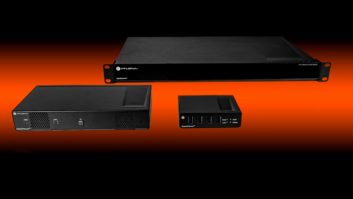
Justin Kennington has been named director of strategic and technical marketing at AV chipset technology company AptoVision. Kennington, who was previously the technology manager of DigitalMedia at Crestron, will be responsible for identifying opportunities to commercialise AptoVision’s AV over IP technology and BlueRiver chipsets, as well as evangelising support for this new paradigm.
At ISE 2016 Montreal-based AptoVision launched the BlueRiver 400 chipset, said to be the first integrated chipset for processing and extending true 4K/60p/4:4:4 AV signals – and its BlueRiver NT+ chipset won an Installation Best of Show Award.
Speaking to Installation, Kennington (pictured) said: “We all see – and it was reinforced recently at ISE – that the trend in the industry is towards moving more and more of our content over Ethernet networks. So as I was thinking about making a change in my personal life, I wanted to find a place where I could be on the leading edge of that transition. I’ve known the guys at AptoVision for two or three years now, and was already pretty well familiar with their technology. I really believe that they – and now we – are at the forefront of pushing this convergence.”
Kennington is widely recognised as an influential technologist in professional AV. In 2014, he received InfoComm’s Young AV Professional of The Year Award, primarily for his role with DigitalMedia in advancing the pro AV industry’s transition to digital AV.
“It speaks volumes to our industry that Justin has joined AptoVision,” said Kamran Ahmed, AptoVision CEO and co-founder. “I’m not sure there’s anyone who’s now more closely identified with the advancement of digital video connectivity in pro AV than Justin. His coming aboard is a tremendous endorsement of our technology and great coup for the company. We’re adding a proven leader to our management team.”
In his new role, Kennington’s goal is “to evangelise the industry: not just our OEM customers who make AV signal distribution equipment, but also their customers,” said Ahmed. “Since we’re taking the lead in driving this paradigm forward, we also have to work with AV integrators for them to feel comfortable with it… It’s like we’re the electric engine in a gas-powered car engine environment: even though it makes sense to convince different car companies to [build] electric cars, we also have to convince the market to demand electric cars.”
Ahmed pointed to a convergence of three technology trends that have created a “perfect storm” for AptoVision’s technology: “For the first time, networking bandwidth is higher than video bandwidth… When we had 1G networking, even 720p or 1080i couldn’t go over 1G because it was two or three times the bandwidth. Now with 10G networks, we [can carry] 1080p, 4K30, 4K60 with a little light compression… and this trend is not reversible because 25G and 100G already exist.
“Second, the price per port is much lower for networking switches than for custom AV switches. A 10G Ethernet port is $100-200, while a custom AV switch is at least $500 per port.
“The third piece that has been missing so far is the technology that can leverage 10G systems to do uncompressed over IP, in order for it to be at least equal to if not better than AV platforms. That technology has to be able to transmit uncompressed, pixel-for-pixel with zero frame latency and maintain the full synchronisation across the network. That’s technology that AptoVision has developed –there’ll be others, but I think we’re at least two years ahead of anyone else doing it.”
This will lead to a changed in the general AV signal distribution market within “a couple of years”, said Ahmed: “You’ll start to see that most companies don’t have incentive to design HDBaseT or any other proprietary platform.”
In a similar timeframe, Ahmed believes the product line will embrace 8K. “Some of our AV processing engine architecture is already 8K scalable and compatible – certainly not on the existing chip, but we’ve already started thinking about how to bring this stuff to 8K – even though 8K is far out. We want to make sure we will be leaders in driving the 8K transition also,” he said.
Kennington added: “I like to point out to people that Ethernet as a technology is 43 years old this year. When I’m at a speaking engagement, I invite the audience to think about technologies that they used today that are 43 or more years old: when you think about it, you get down to things like the wheel, and fire – very few digital communication systems. Ethernet really is where things always end up – I’m very excited to be with a company that is completely aligned with that, and I think we’re really going to lead the charge to help this industry make the transition like so many others have.”







